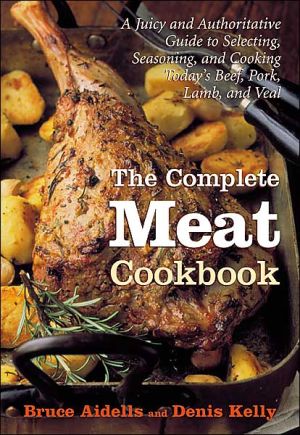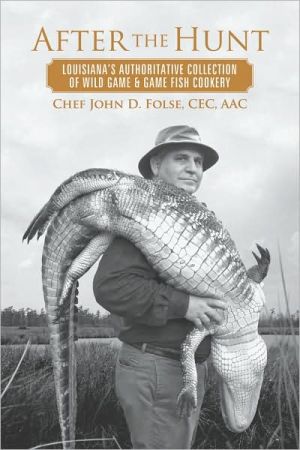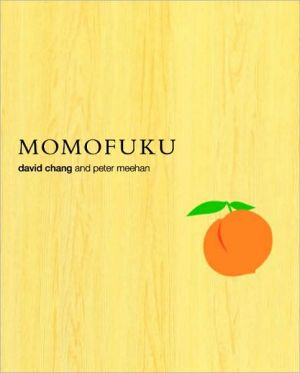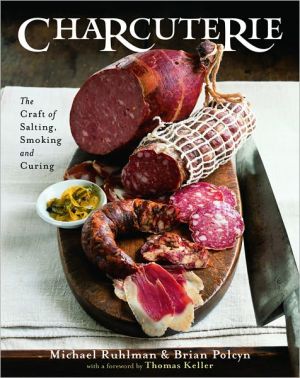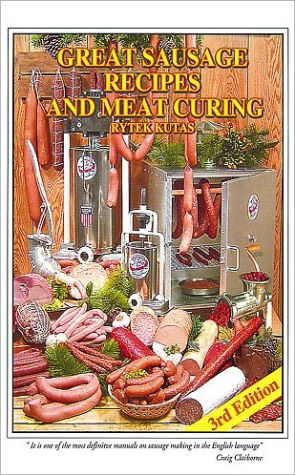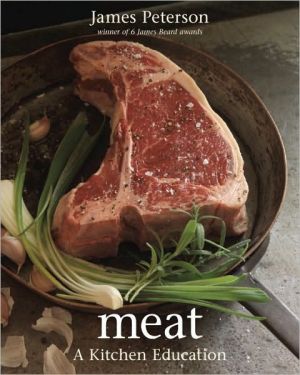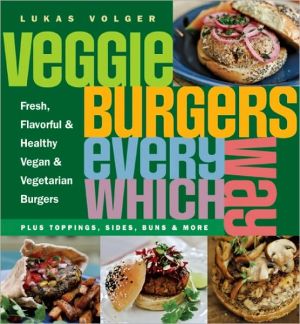The Complete Meat Cookbook: A Juicy and Authoritative Guide to Selecting, Seasoning, and Cooking Today's Beef, Pork, Lamb, and Veal
“Grass-fed.” “Organic.” “Natural.” “Pastured.” “Raised Without Antibiotics.” “Heirloom Breed.” Meat has never been better, but the vast array of labels at today’s meat counter can overwhelm even the savviest shopper. Which are worth the price? Which are meaningless? Bruce Aidells, America’s foremost meat expert and the founder of Aidells Sausage Company, makes sense of the confusion and helps you choose the best steaks, chops, roasts, and ribs and match them to the right preparation method.\...
Search in google:
America is proudly falling in love again--with meat. Whether it's a grilled beefsteak, a succulent lamb chop, a juicy pork loin, or a well-seasoned veal shank, there's nothing like red meat. We're eating it with gusto--about twenty pounds more than we did a decade ago, according to the New York Times. In the past few years, more than one thousand new steak houses have opened. And because today's cuts are leaner than ever, they need special treatment and cooking techniques to make them flavorful, tender, and juicy. Now two colorful collaborators and Julia Child Award winners tell us everything we need to know about cooking meat. In The Complete Meat Cookbook, readers will find: Straight talk on how to make sense of the bewildering variety of meats at the supermarket. The authors discuss their favorite cuts and provide tips on which butchers' favorites to request. Advice on how to season with innovative techniques like dry rubs, wet marinades, brining, herb pastes, and fast sauces. More than 230 recipes, ranging from the eclectic to the ethnic, such as Gordon's Grilled Rib-Eye Steak with Tomato-Chile Vinaigrette, Tuscan Herb-Infused Roast, and Chili Colorado. Many entertaining stories--and tips that will surprise even meat experts. Publishers Weekly The leaner cuts of meat now on the market require extra attention to ensure they don't toughen and dry during preparation, and with that in mind Aidells--owner of Aidells Sausage Company--and Kelly (both coauthored Hot Links & Country Flavors and Flying Sausages) offer more than 230 recipes certain to attract meat-fanciers. They address how to buy meat, flavor it and cook it; specify the temperatures at which various meats should be cooked; and advise using a digital instant-read thermometer to check degrees. Recipes are identified as Fit for Company, In a Hurry, Cooking on a Budget, Great Leftovers and other categories, and they range from familiar--Philly Cheese Steaks, the Classic Hamburger and Grilled Lamb Chops--to nicely inventive: Braised Beef Shanks with Coconut Milk, Ginger and Cumin shows a Pacific Rim influence, while Sauteed Pork Chops with White Wine and Vanilla Sauce adds an even more unusual twist. Master recipes are followed by variations, as in the basic Roast Rack of Lamb and one flavored with Black Bean-Mustard Coating or a Fresh Herb Crust. Complete is a fit adjective for this highly recommended book. Photos not seen by PW. BOMC main selection. (Nov.)
Meat Basics\ A Little History\ Meat and the Human Diet\ Let's face it: from the cave to the condo, we human beings have always been meat eaters. No matter what tales you've heard about some mythic past life of gentle fruit-eating primates, whenever human beings have had the chance, they've eaten meat on a regular basis. Paleoanthropologists think that humankind's great evolutionary leaps were a direct result of the successful pursuit of protein in the form of meat. They feel that the key to humanity's development over the ages has been access to animal proteins through scavenging and hunting in the beginning, then the domestication and exploitation of selected species after the agricultural revolution.\ Our remote ancestors took the first step when they moved out of the forest, where their fruit-based diet had been supplemented by occasional, opportunistic meat eating--pretty much the way chimpanzees eat today. Out on the savanna, huge herds of grazing animals gave early hominids easy access to large amounts of meat on a regular basis. The skulls and jawbones of Homo erectus, the first true human, show that teeth adapted for meat eating and larger brain cavities developed simultaneously. Meat seems to have provided the evolutionary push that resulted in larger brains, full bipedalism, and complex social organization.\ These early humans were omnivorous hunter-gatherers who lived on meat, fruit, roots and tubers, and seeds and leaves. If you examine our diet today, you can see how little we've changed: on a typical day we might eat steak (meat), potatoes (tubers), and carrots (roots) for dinner, along with a salad (leaves) dressed with oil (from seeds) and vinegar (from fruit), and bread (made from seeds of wheat, a form of grass). Even junk food reflects our all-too-human tendency to binge on fat ("Have some more buffalo hump, my dear?") and sugar ("Look at all those ripe plums, yum!") whenever we have the chance.\ Most of humanity's existence has been spent in this hunting-gathering stage, a period that stretches from the emergence of Homo erectus about one and a half million years ago to the Neolithic agricultural revolution, about 9000 B.C. The agricultural diet is an upstart. Contrary to what we usually think, hunter-gatherers had it pretty good. They thrived on a variety of foods gathered from the immediate environment. And they hunted the surrounding countryside for rodents and other small animals, birds, deer, wild cattle, bison, even mammoths and mastodons. If we judge from contemporary hunter-gatherers in southern Africa, the Amazon, or Australia, we see that procuring sufficient food doesn't take all that much time--about 12 hours a week, according to some estimates--so the hunter-gatherer family has plenty of time for leisure and play, to tell stories, weave baskets, or lie around in the shade inventing culture.\ Anthropologists have been debating about the ideal human diet, just like everyone else. Since most of our time as a species has been spent in the hunter-gatherer stage, some suggest that the diet that sustained us for most of our existence must represent the ideal. Paleoanthropologists have found that the hunter-gatherers were significantly taller than early farmers, who derived most of their sustenance from cultivated grains, with very little animal protein in their diet. The hunter-gatherers had strong bones and excellent teeth, unlike the farmers.\ THE AGRICULTURAL REVOLUTION: A DECLINE IN HUMAN DIET?\ Hunter-gatherers had become skilled hunters by the late Ice Age. They followed and harvested the large herds that gathered along the edge of the ice, using finely crafted flint spearheads and the atlatl, or spearthrower, a startling bit of technology that dramatically increased the power of the hunter. Later, bows, nets, and snares gave early humans regular sources of meat for eons in Europe, the Mideast, and Africa. With the change in climate after the last Ice Age and the gradual extermination of large prey through overhunting, humankind gradually began to adopt another, more sedentary way of life that exploited stands of wild grasses (wheat, barley, corn), legumes (lentils, peas, beans), nuts., and fruits. Human beings continued to hunt, but they also began to manage herds of small animals such as sheep and goats, snared small game, and fished and gathered mollusks from rivers, lakes, and seas.\ This new pattern of village life led to the Neolithic agricultural revolution, which resulted in regular sources of storable food for the first time in human history. Grain-based agriculture evolved in the Near East and produced the surplus of wealth that led to the origins of city life--in a word, civilization. But with the great revolution in food production came nutritional problems: a diet based largely on carbohydrates (starches and sugar) was nutritionally inferior to the "ideal" diet of the hunter-gatherers, with its high protein and vitamin levels. As Arno Karlen sums it up in Man and Microbes, "As agriculture spread from its sources in the Near East, China, and Mexico, life expectancy in much of the Neolithic world dipped from the usual forty years of hunter-gatherers to about thirty."\ NO MORE FREE LUNCH\ By the time the great agriculturally based civilizations of Mesopotamia, Egypt, and the Indus had arisen, sheep, goats, pigs, and the wild ox, or aurochs, had been tamed and domesticated. This meat on the hoof was the main source of protein to supplement a diet based on wheat, barley, and other grains. But meat is "expensive" in ecological terms. A large quantity of vegetable food over a long period of time is needed to produce edible protein in the form of meat. So, in time, given the expensive (and perishable) nature of this food, access became restricted to an elite--a condition that would last until the changes wrought by the next great human upheaval, the industrial revolution. Only the aristocracy of priests, warriors, or landowners ate meat on a regular basis; the lower classes of laborers, farmers, and peasants subsisted largely on grains, with meat eaten only at festivals or other special occasions.\ The high-protein diet was restricted to the upper classes up to modern times. Animals were slaughtered on a regular basis only for castle and abbey tables in the Middle Ages. Hunting was the preferred mode of recreation for the nobility during the feudal period, a pastime that provided a valuable byproduct in the form of meat. Peasants were not allowed access to game, and laws against poaching helped to preserve the elite's monopoly on protein. About the only time most of the peasantry saw meat was on feast days, and their physical and mental development suffered accordingly.\ Not until the industrial revolution did meat come regularly to ordinary tables. In the United States during the nineteenth century, immense farms in the Midwest began to produce great quantities of corn and other grains using mechanized harvesters and modern fertilizers. The grain was fed to the surplus cattle in the West and the meat was shipped to market in refrigerated train cars. Thus the whole populace, rich and poor, had access to plenty of meat and protein for the first time, resulting in a great revolution in diet and public health.\ Modern meat has its drawbacks, surely: we worry about its ecological impact and its effect on our cholesterol levels. But we have a largely healthy population in twentieth-century America, with children increasing in stature and life expectancy generation by generation. For those of us who are the children of immigrants--who fled famine and the cultural and economic oppression of a system that limited meat eating and other "luxuries" to an elite--unlimited hamburgers are satisfying. Sinking your teeth into a tender steak fulfills a deeply human need that goes back to Homo erectus crouched by a fire on the open plain. Is it any wonder that we prefer meat cooked on a grill to any other type? Isn't that rare porterhouse we wolf down at the Sunday barbecue a celebration of our ancestry?\ THE QUEST FOR FLAVOR\ One of the great sources of flavor and probably the most revolutionary addition to American cooking arrived with the huge influx of Italians (mostly from the poorer south of that country) in the early twentieth century. Meat-and-potatoes Americans fell in love with garlic, oregano, and spices with their first taste of garlic bread and pizza. Italian chefs also brought us "new" vegetables like zucchini, broccoli, bell peppers, and mushrooms--a welcome alternative to canned peas and spinach, products of the American tendency to cook vegetables into tasteless mush. Garlic and herb pastes and oil-based marinades are two of the most important Italian contributions to meat cookery.\ The Chinese restaurant was another eye-opening place where Americans found startling new dishes with exotic ingredients. Chinese cooks rely on flesh vegetables and little bits of meat, highly seasoned and quickly cooked, to provide lively food that awakens the taste buds and pleases the eye. Stir-frying and grilling marinated meat on skewers are two Asian techniques that are particularly appealing.\ Both Mexican and Southwest cooking have shown us how fiery chiles, herbs like oregano, and spices like cumin can be used to flavor meat that's added to basic ingredients like beans, rice, and corn. These hot cuisines are also surprisingly healthful, using meat sparingly with fresh vegetables and starches; they continue to inspire many of our most creative chefs.\ The cuisines of Louisiana, both Cajun and Creole cooking, rely on dry rubs of various chile peppers, herbs, and spices to season meats before grilling, broiling, or braising. The spicy crust seals in juices and is especially suitable for the leaner meats.\ ECLECTIC INFLUENCES\ In the last 20 years, the range of flavors available to Americans has been increased dramatically in the way it always has, by new waves of immigration. After the Vietnam War, large numbers of Southeast Asians moved to the United States. They carried with them their foodways, bringing new ingredients and cooking styles. Vietnamese, Thai, Cambodian, Burmese, and other Southeast Asians opened restaurants, just as the earlier Italians, Chinese, and Mexicans had, introducing their spicy cuisines to eager American diners.\ The titillating flavors of Thai food in particular are making their way into home cooking. Even supermarkets now offer lemongrass, galangal, fish sauce (nam pla), Thai basil, and coconut milk. Highly seasoned pork or beef is often grilled and served on salads or with lightly cooked vegetables. The combination of bits of spicy meat in a hot, sweet sauce with crisp vegetables laced with chiles, mint, and basil is irresistible. Other Asian cuisines, such as Korean and Japanese, offer soy-based marinades that add intense and delicious flavors to meats of all types.\ As Americans travel throughout the world, we're constantly discovering new tastes and rediscovering some of the earlier popular cuisines in their authentic settings. We rave about Calabrian salsicce (highly spiced fresh sausage), Tuscan fagioli (white beans in virgin olive oil), or Sicilian caponata (a sweet-and-sour eggplant relish). We love Mexican favorites like tacos and tamales, but we're also eager to try regional delights like Yucatan banana leaf tamales or the fabled seven moles (elaborate stews) of Oaxaca.\ As a result, a new style of meat cookery is emerging, eclectic and universal, merging American ingredients and traditions with new and exciting herbs, spices, and techniques in a never-ending quest for flavor.\ What Matters Most in Buying Meat\ What is quality meat? Is it the top grade or the cut with the highest price? For many people, quality means bright red meat devoid of all visible fat. This pretty meat, which breeders have worked so hard to produce, toughens easily and lacks flavor--qualities we'd like to avoid.\ Of course, many factors affect quality in meat: the age of the animal and its breed, its diet, the conditions of slaughter, the temperature at which the meat is stored, whether the meat has been aged, and how it was packed and shipped. All these are important for quality (and mostly unknown to the consumer), but the single most important factor in determining tenderness and flavor is what part of the carcass the meat comes from and how you cook each cut. You'll learn all about this and the USDA (U.S. Department of Agriculture) grading system in the chapters on individual meats.\ Consumers can't be expected to know the answers to all these questions, so we must educate ourselves--one reason you're reading this book--and rely on professional butchers who have been properly trained. There was a time when each neighborhood had its premier butcher shop. Over the years, you got to know your butcher and formed a relationship based on trust and the exchange of information. When you weren't happy with what you got, you let the butcher know about it and got better meat the next time. If you're one of the fortunate few who still has an old-fashioned butcher shop in your neighborhood, let him or her know you care about quality and cultivate this valuable relationship.\ If, however, like most of us, you buy your meat from a supermarket, you have to work to make sure you get the quality and service you need. There always is a butcher back there. Don't just grab a package of meat and run; try to get to know the meat cutters and, especially, the manager. Give them feedback about the meat you buy and ask questions: Where on the carcass does this cut come from? What is the grade of the meat? Who is the supplier? Like any professional butcher, your supermarket meat manager should be an individual of high integrity, knowledge, and skill. A good butcher is like a good auto mechanic, a jewel beyond price, someone who can be important to your enjoyment of life and to your pocketbook. Be persistent and demand quality in meat and you will find it.\ Surprisingly, many warehouse club stores offer consumers very fine meat: USDA Choice beef and excellent pork from the best packers. You usually have to buy sub-primal cuts (see opposite page) or rather large amounts of cut meat, but it's often worthwhile to use what you need immediately and then double-wrap and freeze the rest for up to three months. The prices are very reasonable. As with other butchers, you can (and should) ask about quality and give them feedback about what they sell.\ THE MOMENT OF DECISION: HOW TO CHOOSE GOOD MEAT\ There you are in front of the seemingly endless meat case in the supermarket or standing in front of that upscale butcher who has just called out your number in the crowded shop: what do you look for to get that great steak or chop? What do you tell the butcher, and how can you know that he or she is on your side? How can you be sure you'll end up with a delicious and tender piece of meat to serve at the feast you are planning?\ Well, the short answer is: you can't be absolutely sure, even with the finest butcher and the highest grade of meat. We live in an imperfect world, and many variables that go into getting tender and flavorful meat into the marketplace. But there are some things you can do to increase your chances of finding tasty and tender meat.\ The first thing is to read What Matters Most in Buying Beef (or Pork or Lamb or Veal) at the beginning of each chapter. Look for the qualities for each type of meat: the color of external fat should be white rather than yellow and it should be well trimmed; the color of the meat should be suitable to the type--cherry red to brownish red for beef or lamb, pale pink for pork and most veal; the texture should be fine-grained, not coarse; there should be flakes of intramuscular fat called marbling running through; in general, the meat should look appetizing and appealing.\ Buy the highest USDA grade available that is compatible with your pocketbook. If you are not sure, ask the butcher and insist on getting answers. Don't be impressed by supermarket "fantasy" names such as Butcher's Choice or Five Star Prime. These terms are intentionally misleading--trying to get you to think that the market is selling you USDA Choice or Prime grades of beef. If you have a question about a cut or grade, ask the butcher or push the buzzer in the supermarket.\ Several beef companies and a few lamb and pork suppliers are now offering specially labeled and branded meats. Many use the word "natural" to describe their meat--a term the government has defined to mean meat raised with minimal processing and without the use of artificial ingredients.\ Some companies, such as Coleman Natural Meats and Maverick Ranch Natural Beef, have gone a step further to produce beef free of hormones and antibiotics as well as any pesticide residue. Generally speaking, branded beef will give you a better result than the usual supermarket meat. You might want to try a brand when you see it and decide for yourself. Brands found in regional marketplaces include: Bradley Ranch (B3R Brand) in Texas, Nieman-Schell and Harris Ranch in California, and Brae Beef on the East Coast. Some brands are specific to special meat breeds of cattle, such as Certified Black Angus, Farmland Black Angus, and Certified Hereford Beef. Other brands include Laura's Lean Beef, Double Diamond Brand, and supermarket brands such as Ralph's California Beef and Ukrop's Own Beef in Virginia. Formulated veal is sold under the Provimi and Blue Dutch labels, and range-fed veal is available from specialty producers such as Summerfield Farms by mail-order (see Sources, page 584). Summerfield Farms, Jameson, and other specialty producers also offer high-quality lamb. Amish farmers in the Northeast supply some superb pork to specialty stores. This is not a complete list: you may well find other specialty sources of fine meat.\ But probably the most important factor in getting good meat onto the table is picking the right cut for the cooking method and recipe. Consult Cooking Today's Meat (page 51) and choose the cut carefully. If you are going to grill a steak tonight, don't pick a piece of bottom round, pretty though it might be. Look for a thick, well-marbled T-bone or porterhouse. We suggest preferred cuts in each recipe; also consult the introductions for the various meats to which cuts are suitable for which cooking methods.\ THE FLAVOR STEPS\ How can we coax the flavor we crave from the new, leaner meat? There are three ways: seasoning the meat before cooking, introducing flavors during the cooking process, and adding flavor ingredients after cooking.\ We firmly believe that all meat should be seasoned before cooking to achieve the maximum flavor. At the simplest, this will mean using salt, pepper, and perhaps an herb or spice. More elaborate dry rubs of spices and herbs, herb pastes, wet marinades, coatings, stuffings, and so forth will be listed at the beginning of many ingredients lists as a Flavor Step.\ Salt is the most important seasoning for meat, and salting meat before cooking is the most essential flavor step. Doesn't salting meat before cooking make it lose its juices and become dry and tough? As you'll see if you try our taste experiment (see opposite page), this is simply not true.\ When meat cooks at relatively high temperatures, as in grilling, panfrying, or roasting, it begins to brown, sending up wonderful aromas and developing savory flavors. From a chemist's point of view, the browning involves chemical reactions in the amino acids that make up meat proteins, the caramelization of sugars from the meat (yes, there is some sugar inherent in meat), and the melting and mixing of fats with the proteins. When meat is salted before browning, the salt seems to accentuate the taste, becoming incorporated into the overall flavor profile. In other words, instead of just tasting salty, salt seems to mellow and round out the flavors produced by the browning process. When the meat is salted after browning, the salt is not so easily incorporated into the overall flavor profile. The palate simply tastes salt layered on top of the other complex flavors, only a shadow of the full potential flavor.\ But why take our word for this? Conventional wisdom tells us otherwise. And after all, every palate is unique, and perhaps what tastes good to us may not taste good to you. Conduct your own taste test and see what you think.\ Pepper has an entirely different effect on meat, depending on whether it is added before or after cooking, perhaps because of the complex nature of the spice. In contrast to salt, pepper seems to have much less flavor when added before cooking than when it is added after. For that reason, we add a little bit more freshly ground pepper to meat after cooking to pick up some of the aromatic elements lost in the cooking process. Pepper fanciers may want to try a taste test of their own, using different amounts on preseasoned and postseasoned meats and perhaps experimenting with different types of pepper (white, black, red, green)and grinds (coarse, medium, fine).\ Besides salting and peppering meat, there are several other valuable techniques for introducing flavor into meat before cooking.\ Dry Rubs are mixtures of spices and/or herbs that are rubbed or sprinkled over meat before cooking. Depending on the recipe, the meat can sit in the refrigerator for a day or two or can be cooked immediately. The longer the meat is exposed to the spices and/or herbs, the more they will permeate. Think of spice and herb rubs as dry flavor marinades for meat, poultry, or even fish. Either a dry rub or a wet marinade could be used on the same cut of meat, depending on the flavor profile and texture desired. Dry rubs are better for extremely tender cuts such as beef fillet, since too much time in an acidic marinade can make already tender meats mushy and unpalatable.\ Wet Marinades are used primarily to flavor meat, but they do have some tenderizing effect, especially on thinner cuts and meat of moderate tenderness ("in-between" meats) such as beef sirloin, chuck, top round, and flank steaks or lamb shoulder chops. Their tenderizing properties come from the acidic ingredients, which may include citrus juices, vinegar, wine, beer, or soy sauce.\ With modern meats, tenderizing is not needed as much as in the past, but adding robust flavors is even more important. A few words of caution: some recipes call for marinating for hours or even overnight. Be sure to refrigerate any meat that is marinated for more than two hours to prevent spoilage. Remember that marinades containing high amounts of acid can make small, tender pieces soft and gummy if they're left in the marinade too long.\ Marinades are not really useful for tenderizing large cuts such as roasts, since the marinade does not penetrate deep into the meat. And they don't work for tough cuts such as brisket or shank, which have so much connective tissue that no amount of marination will make them tender. These cuts should always be cooked by moist-heat methods with either a dry rub or wet marinade applied for flavor.\ Pastes are variations of wet marinades. Delicious pastes are made with rehydrated dried chiles, garlic, onions, ginger, and/or fresh herbs such as basil or cilantro. They are pureed with spices and sometimes oil or other liquids in a food processor or blender. The paste is rubbed over the meat, which is left to marinate for a few hours or overnight in the refrigerator before cooking, depending on the recipe. Most of the paste clings to the meat to form a flavor crust as the meat is grilled or roasted.\ Brining is a time-honored technique for both preserving and adding flavor to meat. Traditionally, high concentrations of salt and, sometimes, sugar and spices are either dissolved in water or rubbed directly on the meat. When the high levels of salt penetrate to the center, the meat is cured, and it can be smoked, air-dried, or cooked and eaten as is. This pickling or curing process helps to preserve meat because some of the water is replaced by salt, making conditions unsuitable for bacterial growth. Ham, bacon, salami, and corned beef (see Make Your Own Corned Beef, page 201) are all examples of brined and cured meats.\ Brines have another function: flavor, juiciness, and the texture of meats (especially pork) are all enhanced if the meat spends just hours or up to a few days in a highly flavored brine with a lower salt content than the traditional cure. In this case, some salt and the spices in the brine penetrate the meat. And most important, water from the brine enters the meat to give it a firm and juicy texture. We call this technique Flavor Brining (see page 254). Flavor brines work because the free water in the meat cells has a higher concentration of dissolved substances than the brine, so that water from the brine is drawn into the meat by osmosis. As a result, the meat will actually end up weighing more.\ Stuffing is another old but wonderful technique for increasing flavor and juiciness in meat. The stuffing can be as simple as a mixture of chopped herbs, garlic, and bread crumbs or as elaborate as a combination of ground meats, cognac, and truffles. A stuffing not only enhances flavor but can also improve the appearance and make an ordinary flank steak or breast of veal into a beautiful and elegant dish: Matambre (page 120) and Stuffed Veal for Passover (page 570) are but two examples. There's no reason to limit yourself to the traditional stuffings: prosciutto, coppa (cured pork shoulder), bacon, ham, cheese, anchovies, roasted vegetables, or even dried or preserved fruits can all be used to add excitement to even the most mundane meat.\ Braising and Stewing not only produce a flavorful liquid but also enhance the texture and taste of the meat as it soaks up the stock. In braising, the meat is browned before cooking in liquid; this is one of the most successful ways to provide rich, intense flavor, especially for the less tender cuts. By using the coordinated timing techniques described in this book, you can take advantage of this magnificent cooking method without spending too much time in the kitchen.\ Sauces can enhance the flavors of meat. Barbecue sauces are simple and tasty. We rarely make elaborate, classic French sauces unless we think they're essential for flavor and don't contribute too much fat. We prefer simpler pan sauces based on the cooking juices from properly seasoned and cooked meat with a little wine, beer, or cider added.\ Condiments complement and brighten flavors. Examples include vinaigrettes, mustards, salsas, relishes, horseradish sauces, chutneys, ketchup soy-based dipping sauces, and flavored oils such as truffle oil and rosemary oil.\ Highly Flavored Side Dishes enhance grilled and roast meat: salad herbed flesh tomatoes, or flavored mashed potatoes complete the plate.\ Mom's Standby\ Garlic Salt on Everything\ \ When I was growing up in Los Angeles, my mother had just one spice in the kitchen: a popular brand of garlic salt. She'd take a steak or chop or roast, sprinkle it liberally with the seasoned salt and a little pepper, then cook the meat medium-well. It always came out juicy and full of flavor. Now I know why: it was the meat itself. Mom carefully chose the cuts for our family from the neighborhood butcher, who knew her well and provided her with quality. These days it's hard to find an old-fashioned butcher, but if you do, cling to him (or her--the times are a-changing, even with butchers).\ This early real-garlic deprivation is probably why I went overboard in the garlic department when I got to Berkeley. I joined up with the garlic crazies and was a member of the Lovers of the Stinking Rose, an organization dedicated to garlic excess at every level (would you believe garlic ice cream?). My first (and so far only) movie role was in Les Blank's ode to garlic, Garlic Is as Good as Ten Mothers. If you look closely, you can see me cooking up a storm (I'm the big guy with the beard and leather cap) with Anzonini, a colorful flamenco singer and dancer. Anzonini, a Gypsy from Andalusia who lived in Berkeley, was one of those master meat cooks who taught us the tricks of adding flavor and character to meat by using spice rubs, herb pastes, and marinades. You'll see many of these seasoning strategies in this book; they're the basis of our flavor steps at the beginning of each recipe. B.A.\ Miss Sullivan Visits\ O'Leary the Butcher\ (Poor Devil)\ \ My Aunt Nora was a formidable presence. A maiden lady, a full six feet in her sensible oxfords, with jet-black hair, a pale Irish complexion, and fierce dark eyes, Aunt Nora strode through our neighborhood in Brooklyn, intimidating everyone from the kids playing stickball to the cop on the beat. You heard, "Good day to you, Miss Sullivan," and "How are you this fine day, Miss Sullivan?" on every side as she swept through the crowds of shoppers on 4th Avenue with me and my sisters in tow, on her way to buy the groceries for the week. But while she merely cowed kids, cops, and the neighbors, she put the fear of God into the shopkeepers, especially Mr. O'Leary, the butcher.\ When she entered his shop, O'Leary, himself a stately and imposing man (have you ever seen a lean butcher?), would come out from behind the cooler, bowing and wringing his huge hands. "Ah, Miss Sullivan, I've been saving a beautiful roast for you today," he'd exclaim with notes of hope in his voice. "I'm sure you have, Mr. O'Leary," she'd reply with more than a hint of disdain, "and now let's have a look at it."\ O'Leary would scurry back into the walk-in refrigerator and emerge with a huge, perfectly aged, 7-bone rib roast, deep red meat encircled with ivory fat, and present it to Aunt Nora like a work of fine art. She'd look at it scornfully, prod the edge of fat, peer intently until she discovered a trace of gristle or a chunk of extra fat, and dismiss it with a wave of her hand. "Is this the best you can do, Mr. O'Leary?" she'd say. And O'Leary, shoulders sagging, losing hope, would enter the walk-in again and again, emerging with roast after roast, until one barely met with Aunt Nora's approval.\ "This just might do," she'd finally say, "if you trim it well and deliver it too, and mind, I'm not paying for all that fat and bone." O'Leary and the other butchers would be all smiles now, bowing us out, bestowing pieces of bologna on us kids and savory bits of beef kidney to take home for the cats as we left.\ And the next day, for Sunday dinner, Aunt Nora would season the glorious roast with just a touch of salt and pepper and roast it and roast it and roast it until it was a deep brown on the outside and just as brown all the way through. My father (a budding gourmet of the new school) would try to convince her to leave the meat just a bit pink this time, and I, as I got older, would plead for some herbs or a bit of garlic.\ Aunt Nora would listen carefully, nod once or twice, and then dismiss us with a sniff and a toss of her head. My father and I were Kellys, after all, a clan from far to the north of Kerry, the Sullivan homeland, and therefore suspect with our foreign ways and sophisticated (and most likely depraved) tastes for red meat and exotic seasonings. Foreigners might put garlic and herbs in their food and eat their meat blood-red, but the Sullivans were respectable folk from the true heart of Ireland who would cook their meat until it was done, make plenty of gravy for the mashed potatoes, and boil the carrots and peas until you could chew them without breaking a tooth.\ After dinner, the Sullivan uncles would doze in their armchairs with copies of the Daily News over their faces while we kids played John McCormack records on the ancient wind-up Victrola until Aunt Nora called us for just a little dessert of peach cobbler with fresh peach ice cream to round off the meal.\ D.K.\ \ \ The Ideal Human Diet\ To know what man ate before he invented agriculture is to know his diet during the millions of years during which he adapted to a particular choice of foods. We may thus assume that this choice represents something like his "ideal" diet, and might well form the basis of the advice that the nutritionist is asked to give in formulating diets for health. ... On this basis, the nutritionist would suggest that a diet that contained a fairly high proportion of meat would be basically the diet most suitable for human animals.\ --From "Archaeology and the Nutritionist: The `Ideal' Diet," by John Yudkin, in The Domestication and Exploitation of Plants and Animals, edited by Ucko and Dimbleby\ Learning the Lingo\ Primal cuts are the large sections of meat into which carcasses are divided and sold at the wholesale level to retail butchers. These are illustrated and discussed in detail in the introduction to each type of meat (see A Quick Anatomy Lesson for the Busy Cook, page 85). For example, the beef carcass contains the short loin, which includes two sub-primal cuts, the two major muscles, called the top loin and the tenderloin or beef fillet. These sub-primals can then be cut up by the retail butcher into individual roasts and steaks. Sometimes sub-primal cuts are boxed at the packing house and sold in Cryovac packaging at a warehouse club store and other volume outlets. These can be an excellent bargain.\ How to Read a Retail Label\ The names of the various cuts of meat can be confusing, varying widely from one part of the country to another or even from market to market. Label standards provided by the National Livestock and Meat Board are a first step toward uniformity throughout the United States. The label will help you to identify the primal cut, or area of the carcass that the labeled piece of meat came from, and thus determine the suitable method of cooking by consulting our introductions for each type of meat. The label doesn't, however, provide information about the grade, supplier, and other issues of quality.\ Low-Sodium Diets\ If you're on a low-salt diet, by all means use salt sparingly (you can halve the amounts we call for), but when you use your careful ration, do so where it will have the most impact on flavor. Just sprinkle a little salt on your meat before you cook it. And remember, when you eliminate salty foods from your diet, your sensitivity to salt will increase, so that just a little will go a long way. Some cooks use sea salt or other more intensely salty salt to get more bang per grain.\ MYTHBUSTING\ Salt Before You Cook\ To be objective and make this a controlled "blind" experiment, you'll need at least two people and a 1-inch-thick New York (strip) steak. You will also need a heavy skillet or ridged broiling pan, salt, and a pepper mill.\ Cut the steak in half to make two 1-inch-thick steaks without fat or gristle of equal size and thickness. Season one steak on both sides with enough salt and pepper to provide a light, uniform sprinkling over the meat. Heat your pan over high heat for 5 minutes. Add the two steaks--the preseasoned one and the unseasoned one--and cook for 3 to 4 minutes on one side. Turn the meat over and cook it for 3 to 4 minutes more. You should have two rare steaks with a nicely browned, but not charred, surface. (Cook 4 to 5 minutes per side for medium-rare.) Now, sprinkle the unseasoned steak with about the same amount of salt and pepper you used on the other one. Label the preseasoned steak A and the postseasoned steak B.\ Place both steaks on a platter and turn your back. Have your "assistant" cut equal slices of meat from each steak without telling you which is which. Taste each piece and write down your responses to A and B, but don't tell your partner what you think. Then have your assistant turn his or her back on the steaks after showing you which one was seasoned before cooking and which was seasoned after. Repeat the same blind tasting with your partner and have him or her write down the responses without telling you. Before showing each other the results, try to articulate what differences, if any, there were between the two steaks and why (or if) you preferred one over the other. Then reveal the results and see if you agree or disagree that the preseasoned piece is more flavorful.\ After trying this experiment many times, we've found that presalted (and otherwise preseasoned) meat is much more flavorful and juicy than meat seasoned after cooking.\ MYTHBUSTING\ The Myths of Tenderizing\ For a tough cut of meat, the only way to make it tender is to braise it or stew it slowly. The following timesavers may be popular, but they don't work.\ * Don't buy "tenderized steaks." Sometimes called minute steaks or cutlets, these are thin, tough cuts that have been run through a commercial tenderizer or pounded with a serrated meat hammer. Cardboard tastes better.\ * Avoid chemical meat tenderizers. Usually made from papaya enzymes, they give meat a soggy texture and unpleasant flavor.
INTRODUCTION11 Using This Book14MEAT BASICS25 A Little History: Meat and the Human Diet25 What Matters Most in Buying Meat31COOKING TODAY'S MEAT51 How to Tell When It's Done55 The Doneness Chart56 Choosing the Right Cooking Method: Master Techniques Broiling58 Pan-Broiling60 Sauteing61 Panfrying62 Stir-Frying62 Grilling63 Barbecuing, or Slow-Roasting, in a Covered Grill66 Oven-Roasting66 Braising and Stewing70 Poaching72 Wet Basting72 Steaming73 Pressure-Steaming/Pressure-Cooking73 Microwaving73BEEF: AMERICA'S MOST POPULAR MEAT75 How to Choose a Great Steak92 How to Choose the Best Braised Steak145 How to Choose the Best Beef for Kebabs152 How to Choose the Best Ground Beef and Hamburger155 How to Choose the Best Roast Beef172 How to Choose the Best Pot Roast190 How to Choose the Best Stewing Beef206 How to Choose the Best Short Ribs216 Overlooked but Delicious Cuts226PORK: THE MOST VERSATILE MEAT235 How to Choose Pork Chops, Steaks, and Cutlets260 How to Choose a Pork Roast312 How to Choose Ribs372 Overlooked but Delicious Cuts387 How to Choose Ham: All You Need to Know391 How to Choose Bacon409 Pork Sausage: Simple Links to a Glorious Past410LAMB: ETHNIC FAVORITE AND EPICURE'S DELIGHT427 How to Choose Lamb Chops and Lamb "Steaks"438 How to Choose and Prepare Lamb Kebabs466 How to Choose Ground Lamb470 How to Choose Rack of Lamb, Lamb Loin, and Lamb Shoulder Roasts,478 How to Choose a Leg of Lamb484 How to Choose the Best Cuts for Braised Lamb and Lamb Stew499 Overlooked but Delicious Cuts521VEAL: A TENDER DELICACY529 How to Choose the Best Veal Chops540 How to Choose the Best Veal Scallopini546 How to Choose the Best Veal Roast550 How to Choose Meat for Veal Stew559 Overlooked but Delicious Cuts572SEASONING CHART577SOURCES584ACKNOWLEDGMENTS587INDEX589
\ Publishers Weekly - Publisher's Weekly\ The leaner cuts of meat now on the market require extra attention to ensure they don't toughen and dry during preparation, and with that in mind Aidells--owner of Aidells Sausage Company--and Kelly both coauthored Hot Links & Country Flavors and Flying Sausages offer more than 230 recipes certain to attract meat-fanciers. They address how to buy meat, flavor it and cook it; specify the temperatures at which various meats should be cooked; and advise using a digital instant-read thermometer to check degrees. Recipes are identified as Fit for Company, In a Hurry, Cooking on a Budget, Great Leftovers and other categories, and they range from familiar--Philly Cheese Steaks, the Classic Hamburger and Grilled Lamb Chops--to nicely inventive: Braised Beef Shanks with Coconut Milk, Ginger and Cumin shows a Pacific Rim influence, while Sauteed Pork Chops with White Wine and Vanilla Sauce adds an even more unusual twist. Master recipes are followed by variations, as in the basic Roast Rack of Lamb and one flavored with Black Bean-Mustard Coating or a Fresh Herb Crust. Complete is a fit adjective for this highly recommended book. Photos not seen by PW. BOMC main selection. Nov.\ \
